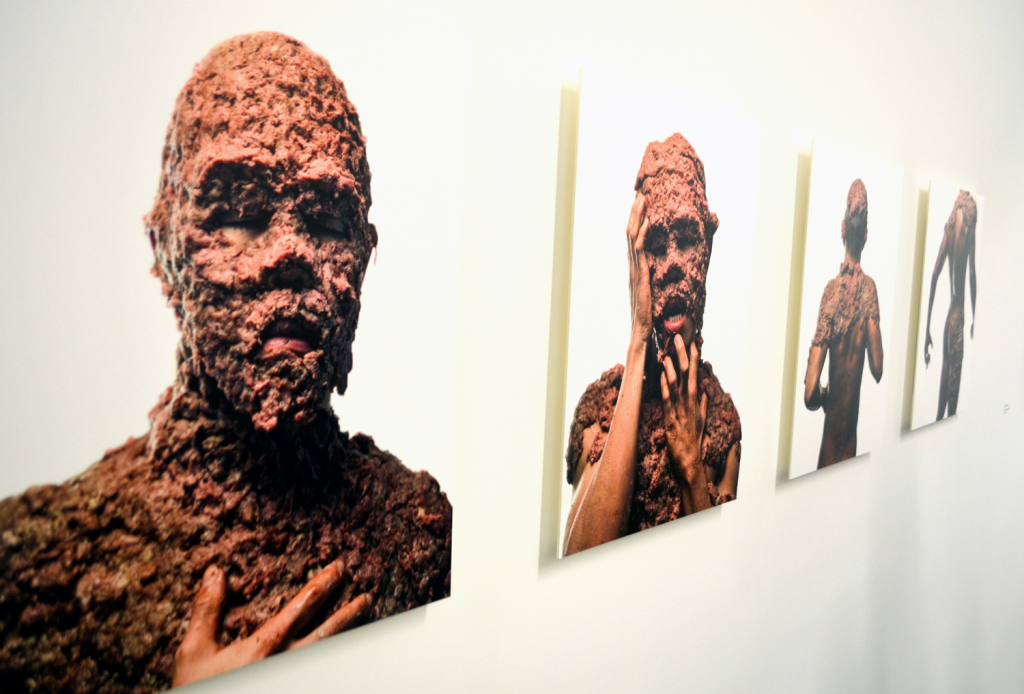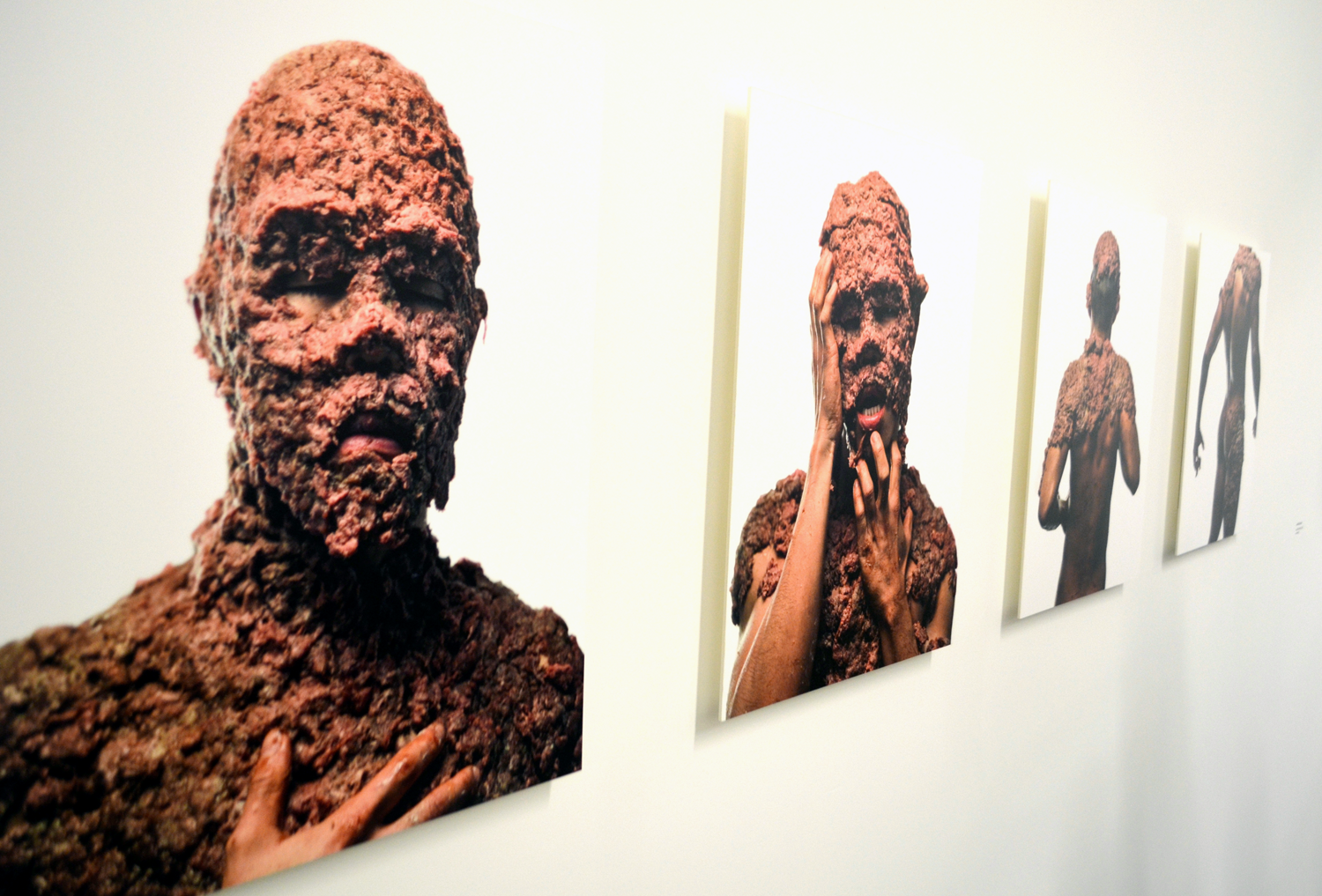
It’s something captured by a war reporter; it’s lifted from a horror film. Raw hamburger sloughs off the artist’s face and naked body, held in various poses. Photography flash-freezes four individual moments of sloppy decomposition. The resulting pictures are part of “Gratification,” a joint exhibition between six artists out of the School of the Art Institute (SAIC), hosted in unit 410 at Mana Contemporary, a satellite space of the Chicago Urban Art Society.
Artist Leonard Suryajaya produced a second skin with repurposed hamburger-product. His grotesquerie flaunts “Gratification’s” title, like many of the works at this exhibition, turning the aesthetics of food on its head. He spits at the title’s implied wish fulfillment with an image that reads like burn damage or radiation scarring.
Each portrait follows the next in close succession, mounted an inch off the wall to produce a dropped shadow. The hand pressed to Suryajaya’s chest in the first still demonstrates a gravitas, an inner peace with his seeming disfigurement. His upturned eyelids, opened mouth, and grasping hands in the second suggest a barely suppressed moan. His beefy chin slides out of his right hand, his head visibly bulges where his left hand applies pressure. The third print looks documentary—anatomizing ripples of matter along his shoulder blades as he tentatively attempts to run. The fourth is almost classical, his serpentine body and generously exposed thigh aligning with the statesmanlike dignity of the first photo in the series.
Suryajaya subversively misappropriates the bloody gore we euphemistically purchase as ground meat. He claims that the politics of objectification and the queer body in the “Beef” series opens the work up to a productive intersection of violence and sexuality. Suryajaya is either deliberately obscuring himself in a grisly process, or desperately clawing away at a false surface. Both actions access the anxieties inherent to discovering a new identity, a new place in life’s relationships. Hamburger itself consists of cuts that have been cast away, chewed up, and spit back out. Suryajaya’s art punningly reproduces appropriate rhetoric for people who are wrongfully used and abused at the margins of gender.
If Suryajaya attempts to discuss marginal gender, Billy McGuinness stands up for those crowded out of the American dream. McGuinness stretched a 37×93 inch canvas across the entrance ramp to a soup kitchen in Wicker Park. At the end of five months, he retrieved the canvas and now presents it—unstretched and unframed—as a tacked-up tapestry of all the tenderness free food, counseling, and laundering represent. McGuinness does, however, still frame “Five Months of Love” inside “Gratification’s” context. By exposing the obstacles that, for some, complicate relationships of need and fulfillment, he challenges the fanciful stylization and blatant understatement of a right to eat as one of simple “wishes granted.”
The final composition on display is the result of random chance: steps, spills, errant gum wads. Just as he has, to some extent, ceded authorial influence and “lost control” of his production, visitors to the soup kitchen experience similar feelings of tenuousness and tentativeness. (His artist’s note cites some 15,000 meals and 800 showers provided over the installation’s duration.) McGuinness uses canvas, the medium of painting, but his painterly gesture is utterly absent, invisible. He accordingly cites the “blind eye” turned to homeless people collecting change on the streets. In making these points, he revitalizes charity’s seriousness—thoroughly dismantling the thought that it is mere “gratification.”
Hyounsang Yoo responds to a not-dissimilar division of high and low with, of all things, Spam. According to curator Nhung Walsh, Spam assumed special significance in Yoo’s Korea, as well as in Walsh’s own home country of Vietnam. “Spam turned into a kind of historical reflection on how people perceived military experience,” she said. During times of U.S. intervention, Spam became a status symbol, difficult to obtain from behind the gates of military compounds. Meditating on this, Yoo built two low trapezoidal walls out of concrete elements cast from Spam cans. The work, “1987-present,” channels the drab prefabricated construction of the army camp with its gray, rounded, modular bricks. Yoo restates the checkpoint’s terms of inside and outside, exclusivity, and suspicion.
Yet Yoo’s work, despite the apparent robustness of its material, runs into tension with its constituent fragility. “1987-present” would never hold back protesting masses. It would, in fact, tumble noisily to the floor at the slightest errant step. It intimidates viewers only insofar as they gingerly tiptoe around the sculpture. The barrier thus disrupts gratification in two senses. It is difficult to gratify the gourmand’s lust for Spam locked behind the implied reinstated barrier, and outright impossible to gratify the base commander’s need for security and protection with this same pathetic implication. By turning this fetishized foodstuff into dead concrete, Yoo perpetuates “Gratification’s” mode of making the edible inedible—turning sustenance into substance. Snatching figurative food from the mouth, he unites with the exhibition’s other artists to hint at different social conditions that, in one way or another, remain ungratifying and undesirable.
Correction January 14, 2014: This article has been edited to reflect the fact that unit 410 in Mana Contemporary is a satellite space of the Chicago Urban Art Society, and for the correct dimensions of McGuinness’s “Five Months of Love”—it is 37×93 inches, not 37×39.

